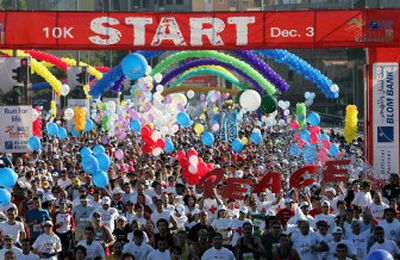Shiite killed in Beirut anti-government protest

BEIRUT, Lebanon – Sunni residents clashed with Shiite protesters in the capital Sunday, killing one man, leaving others injured and raising tension across Lebanon on a third day of demonstrations aimed at toppling the government of Prime Minister Fuad Saniora.
The shooting death of the Shiite protester was the first reported since Hezbollah, the Shiite Muslim movement, and its allies launched their anti-government campaign Friday, sending hundreds of thousands of followers to downtown Beirut, where armor, barricades and troops guarded the government headquarters where the prime minister has taken up residence. Thousands have camped there since, housed in canvas tents spread across downtown; tens of thousands more joined them Sunday.
Lebanese television stations and Hezbollah officials reported several clashes in Beirut and in the Bekaa Valley, and rumors swirled about the extent of the violence. The worst clash was at the edge of the Sunni neighborhood of Tariq Jdideh, for weeks one of the city’s tensest fault lines. Television stations said Sunni residents threw stones at a van carrying Shiite protesters from downtown after nightfall. Passengers got out and, in the ensuing melee, a few cars were damaged before army soldiers broke up the crowd.
Accounts differed on the death of the protester, whom Hezbollah officials identified as a 26-year-old. Some said he was shot during the melee; others after it was broken up. Lebanese security officials said they were still trying to confirm the details of the death.
There is a deep worry here that the mobilization of supporters by Hezbollah and its allies – as well as another demonstration by Hezbollah’s foes during a funeral last month – will worsen clashes along the city’s many fault lines: pro- and anti-government, Christian allies and opponents of Hezbollah, and the sectarian divisions among Christians, Shiites and Sunnis. Several fights had previously broken out in Tariq Jdideh.
In downtown, the biggest crowds gathered since the protests began Friday, giving rise to scenes that took on a surreal air. The crisis could decide the fate of the government and Lebanese politics for years to come.
Organizers said 20,000 runners took part in the Fourth International Beirut Marathon, scheduled long before the demonstration. One of its advertisements read, “Run for life.” The routes were redrawn to skirt parts of the protest, but at one intersection near downtown, the marathon’s posters and flags mixed with green and orange banners carried by demonstrators.
“This is democracy,” said Helena Shaar, a little winded from the race. “Some demonstrate. Some go to a marathon.”